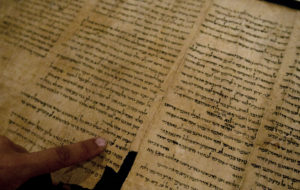Books in Brief: The Damascus Document Reconsidered, Hershel Shanks, BAR 18:04, Jul-Aug 1992.
The Damascus Document Reconsidered
Magen Broshi, editor
(Jerusalem- Israel Exploration Society and Shrine of the Book, 1992) 83 pp., $20.00
This book is a harbinger of things to come. It illustrates the first-rate scholarship that is burgeoning in Dead Sea Scroll research. It also illustrates the cooperative efforts of top scholars working together to make these ancient texts accessible to all.
The subject is a document that has been characterized as “the first Dead Sea Scroll,”a a sobriquet adopted by Magen Broshi, curator of the Shrine of the Book in Jerusalem, in his graceful introduction. In fact, the document was not found in the Dead Sea caves. It was found in the genizah (storeroom) of a Cairo synagogue 50 years before the first Dead Sea Scroll was discovered. Today, it is called the Damascus Document. Two partial copies were found in the Cairo Genizah. Then at least eight fragmentary copies were discovered in the Qumran caves. That is why it is called “the first Dead Sea Scroll.” The fragments from the Dead Sea caves more than double the extant text of the document.
It is a terribly important document. Many scholars believe it is the most significant text yet discovered relating to the origin of the Dead Sea Scroll sect. Equally important, about two-thirds of the document consists of laws of the sect, a gold mine for scholars trying to understand the varieties of Judaism at the turn of the era, out of which both rabbinic Judaism and Christianity emerged.
The jewel of the book is a meticulous transcription by Elisha Qimron, of Ben-Gurion University of the Negev in Beer-Sheva, of the two copies of the Damascus Document from the Cairo Genizah, now in the Cambridge University Library. Remarkable photographs of the manuscripts, taken by G. D. Bye, head of the library’s photography department, accompany Qimron’s transcription on facing pages. The painstaking transcription includes even the spacing of the original, while notes provide variations contained in the eight fragmentary copies from Qumran as well as Qimron’s suggestions to correct the readings in the genizah manuscripts. To make his transcription, Qimron studied not only these pellucid photographs but also the original manuscripts—in both ordinary and ultraviolet light.
The Qumran fragments of the Damascus Document were originally assigned to J. T. Milik for publication. They have recently been reassigned to Joseph Baumgarten of Baltimore Hebrew University in Baltimore, Maryland. He gives us a preview of the contents of these fragments, totaling 689 lines. About half (47 percent) parallels the Cairo Genizah text; the other half is new.
The Damascus Document consists of an introduction known as the Admonition, followed by halakhic (pertaining to religious laws) regulations. In the Admonition, the Pharisaic opponents of the Qumran sect are denounced for “seeking smooth things” and for “turning from the paths of righteousness.” Most of the laws that follow are not stated polemically, however, as they are in the document known as MMT (Miqsat Ma’aseh ha-Torah),b but quite objectively. They cover everything from a ban on slaughtering pregnant animals to a prohibition on conjugal intercourse during pregnancy—so much for the commonly held misconception that all Essenes were celibate. A section on skin diseases contains some of the earliest references to the movement of blood through the body—a fact likely to surprise students of the history of medicine. Another law prohibits a father from giving his daughter in marriage to an incompatible husband; this would be tantamount to plowing with animals of different species, which is prohibited in Deuteronomy 22-10. Thus was the Oral Law derived from Scripture.
At the end of the text is a ritual for the expulsion of those who reject the laws of the community.
Surprisingly, the Cairo Genizah texts of the document, which are medieval copies, are proving to be remarkably accurate when compared to the Qumran copies. In short, medieval copies of rabbinic documents may be more reliable than has previously been thought.
The final section of this book consists of a bibliography of Damascus Document studies from 1970 to 1989 prepared by Florentino García Martínez of the Qumran Institute at Gröningen, the Netherlands, which brings nearly up to date an earlier bibliography prepared by Joseph A. Fitzmyer of the Catholic University of America in Washington, D.C.
All in all, this is a significant addition to the scholar’s bookshelf.
b. See Lawrence H. Schiffman, “The Significance of the Scrolls,” BR 06-05.




